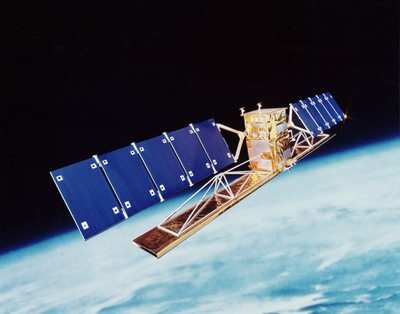RADARSAT-2 Due For Launch Later This Year
ANN has learned that earlier this year, Canada's National
Research Council Institute for Aerospace Research (NRC Aerospace)
has successfully completed an acoustic qualification test on
RADARSAT-2, a new remote-sensing satellite built by MacDonald
Dettwiler and Associates Ltd. (MDA) under contract to the Canadian
Space Agency (CSA).

The test was conducted to certify RADARSAT-2 can withstand the
noise environment generated by the rocket engines during launch
later this year. Conducted in February, it simulated noise
generated during the first 60 seconds of launch, which is the worst
structural environment that the spacecraft will experience during
its mission. It took place in NRC Aerospace's reverberant acoustic
chamber and was completed two days ahead of schedule.
The acoustic test complemented a sinusoidal vibration test
campaign that simulated the launch rocket's excitation at the
spacecraft attachment points. These tests are part of a series of
assembly and testing activities presently underway at the CSA's
premier space qualification centre, the David Florida Laboratory
(DFL) in Ottawa, to enhance confidence in the spacecraft design and
performance before it is shipped to the launch site.
"NRC has the only facility in Canada capable of performing these
tests," said Dr. David Zimcik, NRC Aerospace aeroacoustics expert.
"The RADARSAT-2 test accomplished two things: it proved that the
spacecraft is strong enough to withstand the loads, and it
confirmed that the analytical predictions from the mathematical
model of the spacecraft were accurate."
In all, four test runs were carried out: the first at low level
to identify the structure's signature and ensure everything was
working, a second at predicted flight level, a
protoflight/qualification test at three decibels above flight
level, and a final low level test to confirm that the structure
survived the acoustic environment. The protoflight test, a
60-second blast at 143 decibels, simulated the worst random,
acoustic environment the spacecraft might expect during the first
minute of launch.
"We had some pretty tight tolerances to achieve," Zimcik said.
"If we had too little noise, we would end up under-testing; if we
had too much, we might have broken the structure. With the
automated control system we've developed, however, we were able to
control the noise input into the chamber and match the input
spectrum provided by the supplier. It's a capability unique to our
facility by which we can provide a more accurate environment with
less risk to the spacecraft."
RADARSAT-2 will provide the most advanced commercially available
C-band radar imagery in the world. It is the first commercial radar
satellite to offer multi-polarization, a capability that aids in
identifying a wide variety of surface features and targets. Its
primary payload is a Synthetic Aperture Radar (SAR) antenna that
can capture images at spatial resolutions of 3 to 100 metres over
swath widths of 10 to 500 kilometres. This capability will be
invaluable for a variety of applications, including ice and coastal
monitoring, land use and resource management, cartography, and
disaster response. During its seven-year mission, RADARSAT-2 will
orbit in the same sun-synchronous, polar orbit as its predecessor,
RADARSAT-1, but offset in time, and will circle the earth 14 times
a day at 798 km altitude, covering the entire globe every 24
days.
 Established in 1989 and with
headquarters situated in Longueuil, Quebec, the Canadian Space
Agency (CSA) is responsible for coordinating all civil,
space-related policies and programs related to science and
technology research, industrial development, and international
cooperation on behalf of the Government of Canada. The CSA directs
its resources and activities through four key thrusts: Earth
Observation, Space Science and Exploration, Satellite
Communications, and Space Awareness and Learning. With the overall
responsibility for advancing Canada's space policy and programs, it
leverages international cooperation to champion world-class
scientific research and industrial development for the benefit of
humanity.
Established in 1989 and with
headquarters situated in Longueuil, Quebec, the Canadian Space
Agency (CSA) is responsible for coordinating all civil,
space-related policies and programs related to science and
technology research, industrial development, and international
cooperation on behalf of the Government of Canada. The CSA directs
its resources and activities through four key thrusts: Earth
Observation, Space Science and Exploration, Satellite
Communications, and Space Awareness and Learning. With the overall
responsibility for advancing Canada's space policy and programs, it
leverages international cooperation to champion world-class
scientific research and industrial development for the benefit of
humanity.
The National Research Council (NRC) Institute for Aerospace
Research is Canada's national aerospace laboratory, undertaking and
promoting research and technology development in support of the
Canadian aerospace community in matters affecting the design,
manufacture, performance, use and safety of aerospace vehicles.
 ANN's Daily Aero-Linx (04.16.24)
ANN's Daily Aero-Linx (04.16.24) Aero-News: Quote of the Day (04.16.24)
Aero-News: Quote of the Day (04.16.24) Airborne 04.10.24: SnF24!, A50 Heritage Reveal, HeliCycle!, Montaer MC-01
Airborne 04.10.24: SnF24!, A50 Heritage Reveal, HeliCycle!, Montaer MC-01 Airborne 04.12.24: SnF24!, G100UL Is Here, Holy Micro, Plane Tags
Airborne 04.12.24: SnF24!, G100UL Is Here, Holy Micro, Plane Tags Airborne-Flight Training 04.17.24: Feds Need Controllers, Spirit Delay, Redbird
Airborne-Flight Training 04.17.24: Feds Need Controllers, Spirit Delay, Redbird



